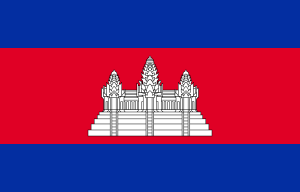Language/Central-khmer/Grammar/Pronouns
Hi Central Khmer learners! 😊
In today's lesson, we will be discussing pronouns in Central Khmer. Pronouns are words that can replace nouns in a sentence. They are used to make sentences shorter and easier to understand. We will look at the different types of pronouns, how they are used, and some examples of their usage.
Personal Pronouns
Personal pronouns are used to refer to people or things. In Central Khmer, there are three types of personal pronouns: singular, dual, and plural.
Singular
Singular pronouns are used to refer to one person or thing. The singular pronouns in Central Khmer are:
- ខ្ញុំ (kɲom) - I
- អ្នក (neak) - you
- គាត់ (kɑt) - he/she/it
For example:
- ខ្ញុំបាទចង់បញ្ចូលអត្ថបទនេះហើយ (kɲom bɑt cɑŋ bɑnclou ɑtɑb dənəh həy) - I want to submit this article now.
- អ្នកបាទចង់បញ្ចូលអត្ថបទនេះហើយ (neak bɑt cɑŋ bɑnclou ɑtɑb dənəh həy) - You want to submit this article now.
- គាត់បាទចង់បញ្ចូលអត្ថបទនេះហើយ (kɑt bɑt cɑŋ bɑnclou ɑtɑb dənəh həy) - He/She/It wants to submit this article now.
Dual
Dual pronouns are used to refer to two people or things. The dual pronouns in Central Khmer are:
- យើង (yeung) - we (two people)
- អ្នកពីរ (neak pii) - you (two people)
- ពួកគេ (puuk kee) - they (two people)
For example:
- យើងបាទចង់បញ្ចូលអត្ថបទនេះហើយ (yeung bɑt cɑŋ bɑnclou ɑtɑb dənəh həy) - We want to submit this article now.
- អ្នកពីរបាទចង់បញ្ចូលអត្ថបទនេះហើយ (neak pii bɑt cɑŋ bɑnclou ɑtɑb dənəh həy) - You (two people) want to submit this article now.
- ពួកគេបាទចង់បញ្ចូលអត្ថបទនេះហើយ (puuk kee bɑt cɑŋ bɑnclou ɑtɑb dənəh həy) - They (two people) want to submit this article now.
Plural
Plural pronouns are used to refer to more than two people or things. The plural pronouns in Central Khmer are:
- យើងច្រើន (yeung crəən) - we (more than two people)
- អ្នកច្រើន (neak crəən) - you (more than two people)
- ពួកគេច្រើន (puuk kee crəən) - they (more than two people)
For example:
- យើងច្រើនបាទចង់បញ្ចូលអត្ថបទនេះហើយ (yeung crəən bɑt cɑŋ bɑnclou ɑtɑb dənəh həy) - We (more than two people) want to submit this article now.
- អ្នកច្រើនបាទចង់បញ្ចូលអត្ថបទនេះហើយ (neak crəən bɑt cɑŋ bɑnclou ɑtɑb dənəh həy) - You (more than two people) want to submit this article now.
- ពួកគេច្រើនបាទចង់បញ្ចូលអត្ថបទនេះហើយ (puuk kee crəən bɑt cɑŋ bɑnclou ɑtɑb dənəh həy) - They (more than two people) want to submit this article now.
Demonstrative Pronouns
Demonstrative pronouns are used to point out people or things. In Central Khmer, there are four types of demonstrative pronouns: near, far, near-plural, and far-plural.
Near
Near demonstrative pronouns are used to refer to people or things that are close by. The near demonstrative pronouns in Central Khmer are:
- នេះ (nəh) - this
- នោះ (nuh) - that
For example:
- នេះជាអត្ថបទដែលខ្ញុំបាទចង់បញ្ចូល (nəh cie ɑtɑb dəl kɲom bɑt cɑŋ bɑnclou) - This is the article that I want to submit.
- នោះជាអត្ថបទដែលអ្នកបាទចង់បញ្ចូល (nuh cie ɑtɑb dəl neak bɑt cɑŋ bɑnclou) - That is the article that you want to submit.
Far
Far demonstrative pronouns are used to refer to people or things that are far away. The far demonstrative pronouns in Central Khmer are:
- នៅទីនេះ (nəv tii nəh) - this (far away)
- នៅទីនោះ (nəv tii nuh) - that (far away)
For example:
- នៅទីនេះជាអត្ថបទដែលខ្ញុំបាទចង់បញ្ចូល (nəv tii nəh cie ɑtɑb dəl kɲom bɑt cɑŋ bɑnclou) - This (far away) is the article that I want to submit.
- នៅទីនោះជាអត្ថបទដែលអ្នកបាទចង់បញ្ចូល (nəv tii nuh cie ɑtɑb dəl neak bɑt cɑŋ bɑnclou) - That (far away) is the article that you want to submit.
Near-Plural
Near-plural demonstrative pronouns are used to refer to multiple people or things that are close by. The near-plural demonstrative pronouns in Central Khmer are:
- ទាំងនេះ (teung nəh) - these
- ទាំងនោះ (teung nuh) - those
For example:
- ទាំងនេះជាអត្ថបទ


